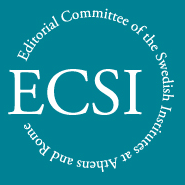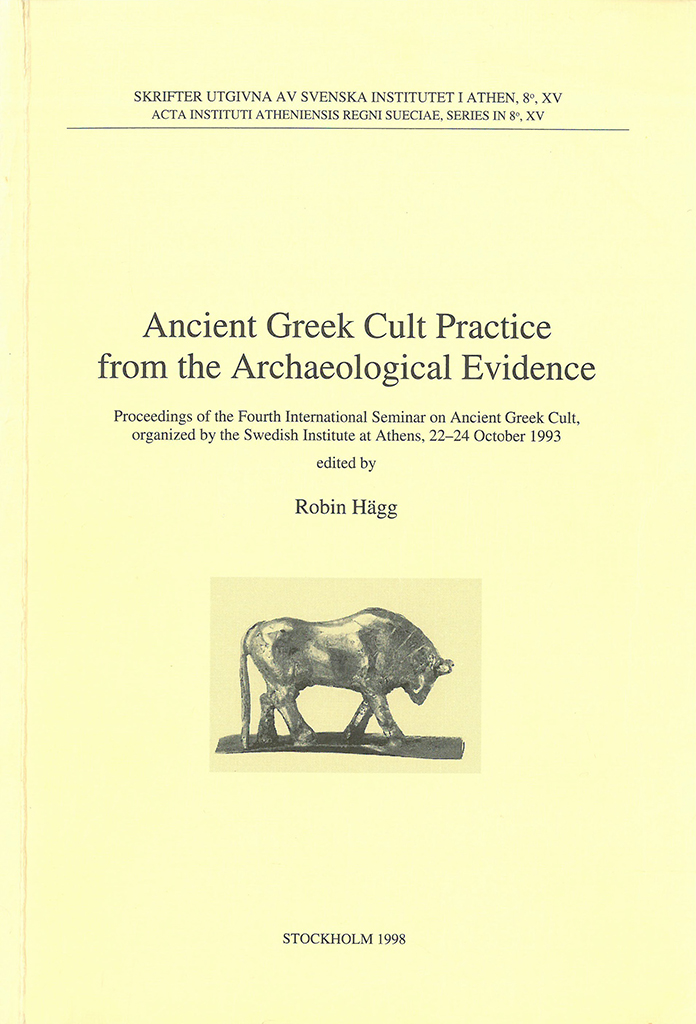Published by the Swedish Institute at Athens. Distributed by Astrom Editions. Ancient Greek cult practice from the archaeological evidence. Proceedings of the Fourth International Seminar on Ancient Greek Cult, organized by the Swedish Institute at Athens, 22–24 October 1993 Edited by Robin Hägg Abstract A collection of thirteen papers, read at an international seminar in Athens, that deal with various phenomena of Greek cult practice, analyzing the information gained from the archaeological evidence. Among the special topics discussed are cult practice in the acropolis sanctuary of Minoa on Amorgos, the sanctuaries in the Artemision of Ephesos, the role played by osteological analysis in the understanding of Greek sacrificial practice, the interpretation of animal bones and fire traces connected with ritual feasting in the Herakleion on Thasos, ritual and society in Early Iron Age Corinthia, small dedications from the Archaic temple of Poseidon at Isthmia, altars in Greek hero cults, the early history of the sanctuary of Demeter and Kore at Eleusis, a sacrificial area near the sanctuary of Apollo Daphnephoros at Eretria, terracotta plaques and other finds from the sanctuary of Demeter and the Dioscouri at Messene, the interpretation of sickles in Greek sanctuaries, changes in votive practice from Classical…
Published by the Swedish Institute at Athens. Distributed by Astrom Editions. Ancient Greek cult practice from the epigraphical evidence. Proceedings of the Second International Seminar on Ancient Greek Cult organized by the Swedish Institute at Athens, 22–24 November 1991 Edited by Robin Hägg Abstract Thirteen papers read at an international seminar in Athens deal with various phenomena of Greek cult practice, analysing the information contained in inscriptions, such as sacred laws. Among the special topics discussed are: the definition of “state cult”, the arrival of Asclepius in Athens, the rite of theoxenia, regulations concerning everyday life in a Greek temenos, the occurrence of cakes in sacrifice regulations, the food and drink at two festivals on Delos, the role of musicians in Greek cult, the sacred laws of Lykosoura, the cult of Artemis Ortheia at Messene, the cult of Poseidon-Erechtheus on the Acropolis of Athens, the interpretation of lead curse tablets and other magical texts in Greek from Cyprus and Asia Minor. Contents ‘Preface’, p. 7. Sara B. Aleshire, ‘Towards a definition of “state cult” for ancient Athens’, pp. 9–16. Kevin Clinton, ‘The Epidauria and the arrival of Asclepius in Athens’, pp. 17–34. Michael H. Jameson, ‘Theoxenia’, pp. 35–57. György Németh, Μεδ’ ὄνθον…
Published by the Swedish Institute at Athens. Distributed by Astrom Editions. The Greek Renaissance of the eight century B.C. Tradition and innovation. Proceedings of the Second International Symposium at the Swedish Institute at Athens Edited by Robin Hägg Abstract ”The Greek Renaissance” designates the formative period of the Greek society of historical times during the latter half of the eight century B.C. The 24 papers originally read at a symposium deal with various aspects of this period; they are followed by transcripts of the discussions of the symposium. The contributors are specialists in ancient history, archaeology, philology, epigraphy, art history and history of religion. Among the topics dealt with are historical reasons for the rediscovery of the Mycenaean past in the age of Homer, the regional pottery styles, burial customs and attitudes to death, Oriental traits in epic poetry, the origin and early spread of the alphabet, Late Geometric art, especially vase painting, early Greek religion, especially cult images and altars, the growth of the pan-Hellenic santuaries, diviners and magicians, the working of bronze and ironin sanctuaries, obeloi as pre-monetary currency, the size and growth of populations, Homeric medicine, cult of the ancestors, the symposion as social organization, the customs…

